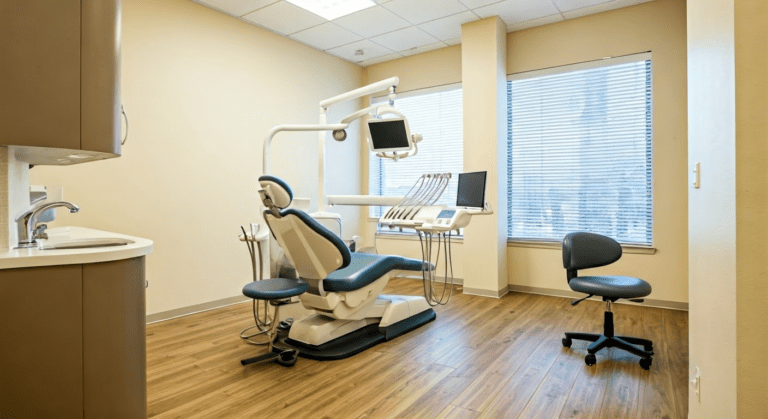Boost Your Practice Performance with the Dental Metrics
Are last-minute cancellations and declining case acceptance rates impacting your dental clinic’s revenue? It’s difficult to identify gaps and make informed decisions without tracking the right dental metrics. This blog will walk you through essential key performance indicators (KPIs) for dental offices and how to use them to improve efficiency, profitability, and patient satisfaction.
Why Dental Metrics Matter for Your Practice’s Success?

Tracking dental practice metrics is essential for long-term growth and efficiency. You gain valuable insights into your practice's performance by analyzing key performance indicators (KPIs) like new patient numbers, case acceptance rates, and production goals. Monitoring patient retention, satisfaction, and engagement allows you to make data-driven improvements. Understanding financial metrics such as collection rates and annual patient value helps you stay on track with your revenue goals.
- Make Better Decisions – If new patient numbers drop, it may signal ineffective marketing. A high no-show rate could mean appointment scheduling doesn’t align with patient availability. Identifying these trends early allows for timely adjustments.
- Keep Your Practice Healthy – Just as routine check-ups prevent dental issues, monitoring dental key performance indicators like revenue, patient retention, and cancellations help spot operational problems before they escalate.
- Find Areas to Improve – A low case acceptance rate might indicate that patients need better education on treatments. High overhead costs could suggest the need for resource optimization. Recognizing these patterns helps streamline operations and boost profitability.
Key Performance Indicators (KPIs) Every Dental Office Should Track

Tracking key performance indicators (KPIs) is essential for improving your dental practice’s efficiency and profitability. Metrics like case acceptance, patient retention, and production goals offer insights into financial health and care quality. Monitoring new patients, collection rates, and staff productivity helps with strategic planning. Using practice management software, you can optimize performance and drive long-term success.
Production Per Visit (PPV)
PPV measures the average revenue generated from each patient visit. This metric helps analyze treatment acceptance rates and identify trends in production. If PPV is declining, it may indicate fewer high-value treatments are being accepted or that appointment efficiency needs improvement.
For example, if a dental office notices a drop in PPV, it could mean patients are opting for basic procedures while avoiding larger treatments. Monitoring this KPI allows practices to adjust treatment planning, patient communication, and scheduling strategies to maximize revenue per visit.
By keeping a close eye on these KPIs, dental offices can make informed decisions, enhance patient care, and optimize their financial performance.
Annual Patient Value (APV)
APV measures how much revenue each active patient brings in annually. It’s calculated by dividing total collections by the number of active patients. A rising APV suggests patients are opting for more treatments, which is a positive sign for both patient care and profitability. Comparing APV with Production Per Visit (PPV) helps determine if patients are visiting frequently enough or if there’s potential revenue left untapped due to unscheduled treatments.
Pre-Appointment Rate
This metric tracks the percentage of active patients who already have their next appointment scheduled. A strong pre-appointment rate means your practice is retaining patients and ensuring continued care. If the percentage is low (around 30-40%), it signals that many patients are leaving without scheduling follow-ups, leading to lost revenue and lower patient retention.
Improving this metric can help boost appointment volume and ensure patients receive consistent dental care, ultimately increasing production and revenue.
Patient Retention Rate
Patient retention rate is a significant measure of patient loyalty and satisfaction. A high retention rate indicates exceptional service delivery encompassing quality care, effective communication, and convenience.
If the patient retention rate is found lacking, it's advisable to delve deeper into elements like patient experience, operational efficiency, and communication quality. Enhancements in these areas can significantly boost your patient retention, translating to a stronger patient base and sustainable growth.
Case Acceptance Rate
Case acceptance rate, which measures the percentage of patients accepting the prescribed treatment plans, provides invaluable insights into patient behavior. A low case acceptance rate can hint at various issues - potentially ambiguous diagnosis explanations or steep treatment costs.
Working on patient education and improving communication about diagnoses can help address a low case acceptance. This KPI, therefore, is fundamental for realizing the practice's potential for revenue generation and growth.
Hygiene Re-Appointment (Re-care) Rate
Hygiene re-appointment (or recare rate) is a crucial KPI to measure patient retention and gauge the effectiveness of preventive care offerings, including additional services. A high rate in this metric indicates excellent dentist-patient rapport and patient faith in the quality of your care.
By tracking this metric, practices can sharpen their focus on enhancing their preventive care services and strategies for better patient engagement, thereby securing more consistent revenue from hygiene appointments.
Overhead, Revenue, and Profit
Tracking overhead costs alongside revenue and profit metrics provides an insightful peek into the financial health of your practice. Staff labor expenses, operation costs, and other overhead costs offer a comprehensive view of resource utilization and efficiency.
Striking a balance between minimizing overhead costs (without compromising on quality care delivery) and maximizing revenue will optimally increase profit margins. This trio of financial KPIs, when tracked methodically, can vastly improve financial management and help achieve your financial goals within your practice.
Appointment No-Show/Cancellation Rate
Appointment no-shows and cancellations can cost your practice valuable revenue opportunities and disrupt daily operations, so it’s important to keep a close eye on these metrics. Tracking this metric can help highlight any underlying issues with patient scheduling and overall office workflow.
If this rate is observed to be high, a re-evaluation of the appointment scheduling and reminder systems may be required. Efficient strategies to minimize no-shows and cancellations would contribute significantly to optimizing staff productivity and practice's revenue generation.
How Tracking Dental Practice Metrics Enhances Patient Experience?

Tracking dental practice metrics not only boosts practice performance but also enhances the patient experience. By monitoring key indicators like patient satisfaction levels, treatment plan acceptance rates, and hygiene appointment attendance, your dental practice gains valuable insights to make necessary adjustments.
This proactive approach ensures patient care is optimized, leading to improved patient engagement and satisfaction. Implementing data-driven strategies based on these metrics fosters a patient-centric environment, ultimately enhancing the overall quality of care and strengthening patient relationships.
Using AI and Automation to Optimize Dental Practice Performance Metrics
Integrating AI and automation into your practice can significantly improve dental practice performance metrics by reducing manual tasks, increasing efficiency, and enhancing patient experiences. Here’s how AI-driven solutions can help:
Streamlined Online Appointment Management:
AI-powered scheduling tools ensure patients can easily book appointments through an online appointment system without staff intervention. These tools analyze appointment trends, predict peak hours, and automatically adjust availability to minimize gaps and maximize efficiency.
Instant Patient Communication for Better Engagement
AI-driven chatbots and automated messaging systems facilitate instant patient communication, answering inquiries, sending appointment reminders, and providing post-treatment care instructions. This reduces missed appointments and enhances patient satisfaction.
Automated Patient Follow-Up for Higher Retention
AI tools can send personalized messages, check on treatment progress, and remind patients about upcoming check-ups. This proactive patient follow-up improves patient loyalty and increases retention rates.
Seamless Online Payment Integration for Faster Transactions
AI-powered billing systems simplify the payment process by offering secure online payment options, automating invoicing, and tracking outstanding balances. This reduces administrative workload and enhances financial efficiency.
By leveraging AI and automation, dental practices can optimize key performance indicators for dental offices, enhance patient experiences, and improve overall operational efficiency.
How to Track and Optimize Your Dental Practice Metrics?

Tracking and improving dental practice performance metrics is key to running a smooth and profitable practice. Here’s how you can do it effectively:
Implement AI-Powered Practice Management Software
Use AI-driven tools to automatically collect and analyze data, making it easier to track KPIs like patient retention and revenue growth. These tools integrate with your existing systems, providing real-time actionable insights without manual effort. With better data accuracy, you can make informed decisions to enhance practice efficiency.
Monitor Online Appointment Trends
Track online appointment bookings to see when patients prefer to schedule visits and identify peak hours. If cancellations are high, you can adjust scheduling policies or send automated reminders to reduce no-shows. Understanding booking patterns helps optimize staff availability and improve patient flow.
Enhance Instant Patient Communication
Use automated messaging systems for instant patient communication, including appointment reminders, confirmations, and follow-ups. Quick responses make patients feel valued and improve their overall experience. Timely communication also reduces missed appointments and increases patient loyalty.
Track Financial Performance with Online Payment Systems
Monitor collections through online payment tracking to identify trends in billing efficiency and unpaid balances for prospective customers. If payment delays are frequent, you can introduce flexible payment options or automated reminders. A seamless billing process ensures a steady cash flow and reduces administrative workload.
Analyze Patient Follow-Up Effectiveness
Measure how well your patient follow-up system is working by tracking response rates and treatment completion. If patients are not following through with treatments, consider improving educational materials or follow-up reminders. A strong follow-up system leads to better patient outcomes and long-term relationships.
How Can Practice by Numbers Improve Your Dental Metrics?
At Practice by Numbers, we provide intuitive and comprehensive tools designed to enhance your dental practice metrics effortlessly and monitor your practice’s performance. Our platform seamlessly integrates with your existing systems, offering real-time monitoring and in-depth analysis of key performance indicators to give you a clear picture of your practice’s health.
We simplify complex data, presenting valuable insights in an easy-to-understand format. This allows you to make informed decisions that streamline operations, boost productivity, and enhance patient satisfaction. With Practice by Numbers, you gain a powerful solution to optimize efficiency, improve patient engagement, and drive profitability for long-term success. Dial 866-216-8416 today.
Conclusion
Understanding and adequately using dental metrics are critical for dental practice owners in establishing a thriving dental practice. These metrics not only provide insights into the overall health of your practice but also offer actionable data to enhance performance, productivity, and profitability.
By keenly tracking and analyzing metrics like production, collections, new patients, patient retention rate, and case acceptance rate, practice owners can make informed decisions that align with their strategic goals. Incorporating advancements like AI and automation in metric tracking further simplifies the process, rendering real-time insights that fuel proactive responses to observed trends.
Hence, mastering the art of dental metrics is the way forward to build a more efficient, patient-centric, and successful practice.




